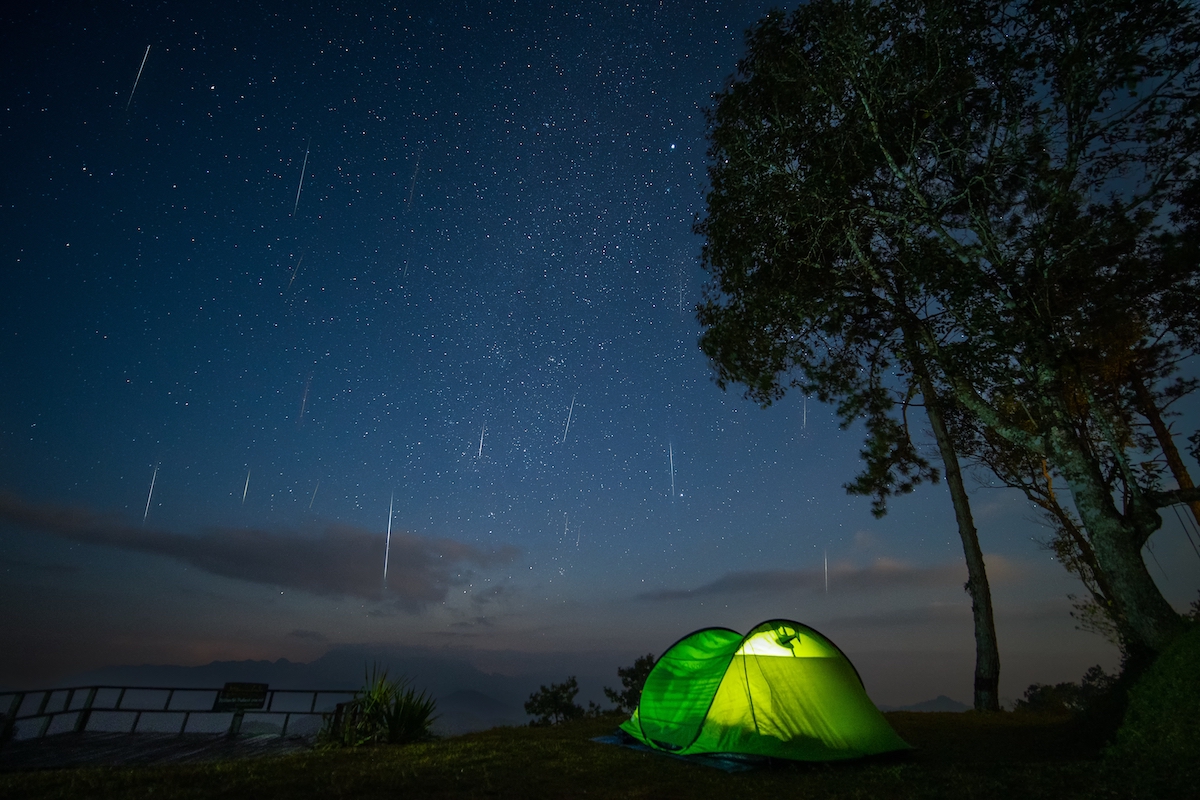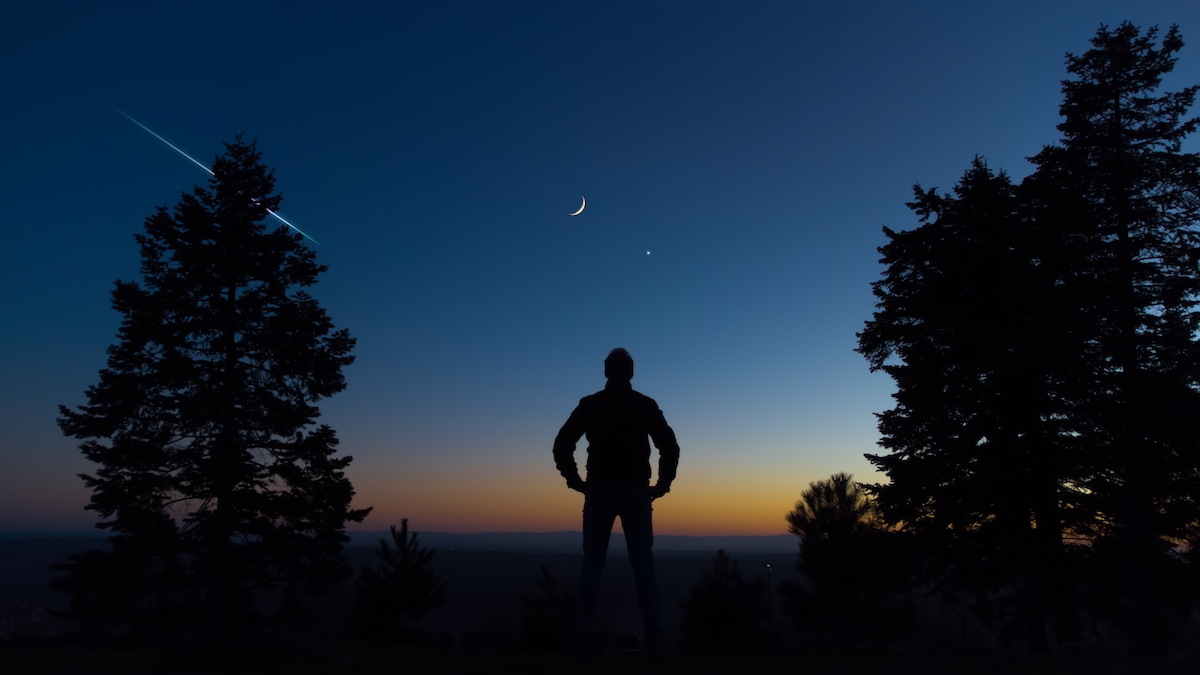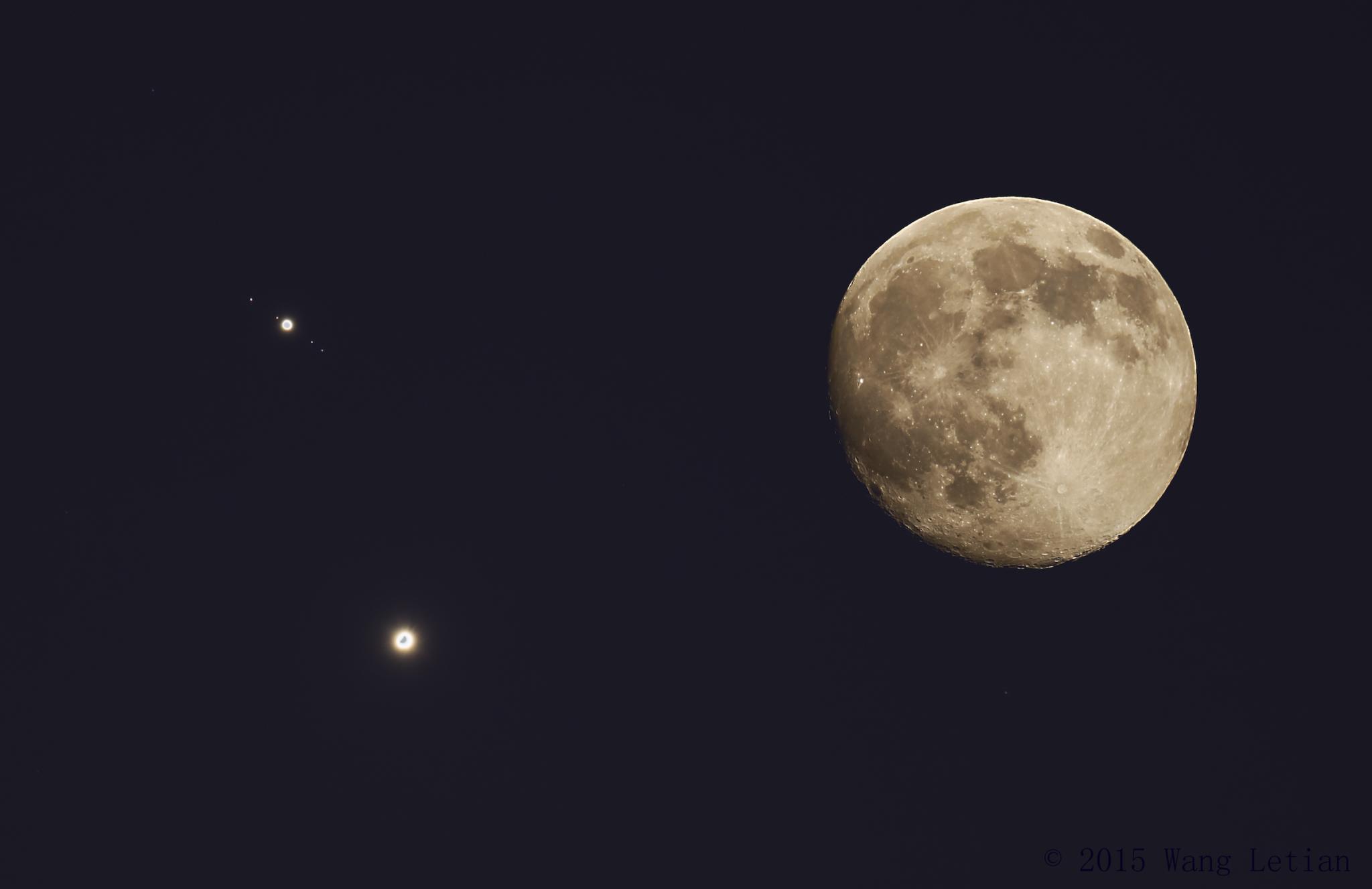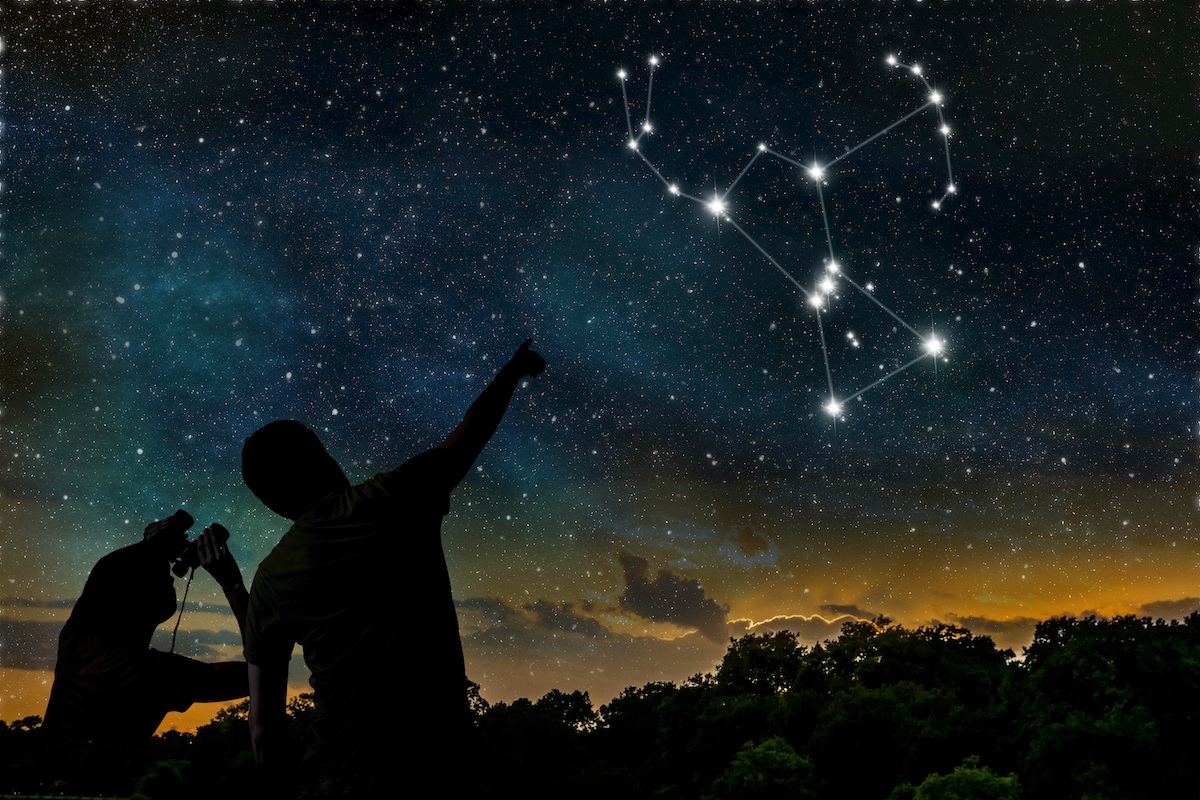
2023 Astronomy Calendar with Monthly Highlights
For daily wit & wisdom, sign up for the Almanac newsletter.
Here it is! My 2023 astronomical calendar lists the best night sky events of the year—with an eye to highlighting the most amazing, rare, and worthwhile sky-happenings that any regular stargazer can see without special gear. I suggest readers save it for year-long reference. Without further ado, let’s see what’s happening in the sky in the new year!
Unlike many astronomy guides, everything mentioned here is visible without binoculars, telescopes, or equipment, skipping celestial events that demand jetliner travel. Instead, here are the easy, in-your-face occurrences, like the brilliant don’t-miss three-way conjunction that unfolds in evening twilight just as you’re awaiting the Independence Day fireworks.
Since this is a year-long chronicle for stargazers, you’ll want to save this, perhaps by marking each event on the newly-received calendar someone will give you as a holiday present. Or print it out and let a magnet hold the current page to your fridge. But don’t simply glance at it once or you’ll miss a truckload of spectacles.
An Unusually Good Year for Sky Watchers
So happens, 2023 is an unusually good year in the sky. That’s true, even though the media will mistakenly hype a couple of events that are actually unreal.
2023 Astronomy Highlights: A General Overview
First, a general overview for the year . . .
2023 is the best year of the decade for meteors
Every night around six “shooting stars” zoom across the sky every hour between midnight and dawn, when Earth has rotated your location to the front side of our planet, the leading hemisphere in our orbital motion, so that the air above your region smashes into any space debris. You’ll see perhaps a third that frequency before midnight, when you’re on Earth’s trailing hemisphere so that the tiny apple-seed-sized icy particles—mostly debris from long-ago passing comets—must catch up to your location from behind.
Each year brings a dozen minor meteor showers that then increase the number to roughly one meteor every six minutes under ideal conditions, a wimpy enough rate to be ignored. See the 2023 Meteor Shower Calendar.
That leaves us with “The Big Three.” These deliver a meteor-a-minute and sometimes more. They’re true don’t-miss events. We’ll pass on the first this year, the Leonids. They typically put on a rich display every 33 years and most recently treated early risers to seven brilliant green shooting stars every minute between 2 AM and dawn on November 18, 2001. Truly awesome, however we’re not expecting another great Leonids display until 2099.
That leaves the famous summer Perseid meteors occur every August 11-12, and the Geminid meteors on December 13. Being in a big city pretty much ruins those showers by camouflaging all but the most brilliant, leaving just a few visible each hour. A bright moon inflicts the same damage. But this year the Moon will be harmlessly thin or absent for both showers. This doesn’t happen often. In fact, 2023 is the best year of the decade for meteors!
So if you can get to a rural site with a big open clearing of sky you’ll see a Perseid meteor a minute on August 11-12 starting around midnight (and one fourth that rate at nightfall). See the Perseid Meteor Guide near the event.
And you’ll enjoy the same sumptuous 60-per-hour richness for the Geminids, with the added advantage of that show conveniently starting at dinnertime. Plus the Geminid meteors travel at only half the speed of the summer Perseids, a mere 20 miles a second, making them more forgiving in case you were looking at a slightly wrong piece of sky – you’ll have time to spin your head to the right direction. Alternatively, do you have friends in the country who have a hot tub? That’s the ideal way to observe the December Geminids. See the Geminid Meteor Guide near the event.

2023 is NOT a great year for eclipse watchers (wait until 2024!)
Lunar eclipses: A cursory look at astronomy data seems to promise two eclipses of the Moon in 2023. But neither is visible from the US nor virtually all of Canada, and even if they were, one is a barely-there partial eclipse in the wee hours, where a tiny spot of darkness will strike one edge of the Moon for a few minutes. The other is a penumbral eclipse in which Earth’s virtually invisible outer shadow barely hits the Full Moon so that nothing will seem to be happening. And even that only occurs on the opposite side of Earth, an “event” solely for Siberian insomniacs.
Solar eclipses: There are two eclipses of the Sun in 2023. Total solar eclipses are roughly one million times more spectacular than any other kind, but this year you’d have to go to westernmost Australia on April 20, or else book a tour stopping at one of the tropical islands northwest of that country, to observe solar totality.
But there’s also an annular eclipse. The word sounds as if it means a yearly event, but it actually refers to an “annulus” or ring of sunlight. That’s because on October 14 the Moon will be near the farpoint of its oval orbit and will therefore appear too small to completely block out the Sun. This results in a “ring of fire,” an eyesight-threatening brilliant ring surrounding the inky black New Moon, so that you must use continuous eye protection such as a shade 12, 13, or 14 welders filter. No shade lower than 12 is safe.
For this event, there’s a ribbon-like path of annularity whose map is widely available, like at NASA’s website. Basically this “ring of fire” can be viewed along a roughly 150-mile-wide pathway that goes southeastward from the Pacific Northwest through several southwestern US states before crossing the Gulf of Mexico, the Yucatan peninsula, and sweeping across northern South America.
See all eclipse dates and details for 2023.

2023 Astronomy Highlights by Month
No travel required: Here are the stay-at-home spectacles and conjunctions, most of which can be well seen even from light-polluted cities. They’re listed chronologically.
Winter Season, 2023
January Sky Events
- January 3: Don’t miss this super-close meeting of the Moon and orange Mars, still very brilliant since its opposition and closest-approach happened only a few weeks ago in early December. City lights can’t spoil this one. A backyard telescope can boost the fun by revealing the northern Martian polar cap and some dark surface markings.
- January 14 and 15: If you’re an early riser at 6:30 AM with a south-facing window, look at blue Spica, Virgo’s “alpha” star, as it meets this Moon.
- January 19: If you’re up at 6:30 AM and have an unobstructed view of the southeast horizon, that “star” to the left of the crescent Moon is the planet Mercury.
- January 22: Look low in the southwest at around 4:45 PM. Though just 10° high, which necessitates an ocean-flat horizon; don’t bother if hills, trees, or houses block the horizon in this direction. The extreme super-brilliance of Venus makes that Evening Star a don’t-miss target, especially with that little “star” (the planet Saturn) hovering next to it in the fading dusk.
- January 23: Venus and Saturn are not as close together tonight, but more than compensated by the thin crescent Moon now to their upper left. A Three-For-One special. But quite low at 4:45 PM so once again you need a flat horizon.
- January 25: Jupiter is that brilliant “star” just above the Moon tonight. High up, easily seen from cities, and never mind watching the clock. Anytime after 5 PM will work.
- January 28: Today brings two worthy sights, at dawn and at dusk. First at 6:30 AM, very low in the southeast, the single bright star near the horizon at an impressive magnitude zero is Mercury. Johann Kepler said he’d never once seen the innermost planet. But since you’re not attempting this from his native Poland where it’s lower down, you’ve got a shot at it.
- January 28: Today’s dusk-and-later spectacle is best for binocular or telescope owners. The 1st quarter Moon is high up at nightfall and displays the month’s richest lunar detail. To its left, the only green “star” is the strange planet Uranus. Be sure to stress its first syllable.
- January 30: The Moon closely meets Mars for the second time this month. Still in the constellation Taurus, look at how much that orange “star” has faded since its January 3 conjunction, as Earth keeps racing away from it at 66,000 mph.
February Sky Events
- February 10: Any evening around now, watch the two brightest “stars,” Venus and Jupiter, get closer and closer together at 6 PM. Venus is always the brightest of the pair.
- February 21: This evening at roughly 6 to 6:15 PM, look lowish in the west-southwest for a true spectacle, a vertical line composed of the night’s three brightest objects. These are Venus, Jupiter, and the crescent Moon below both planets.
- February 22: The crescent Moon is now extremely close to Jupiter, with Venus below them both. Look low in the west-southwest at around 6:15 PM.
- February 27: A double-treat. The Moon meets Mars again, which at nearly magnitude zero is still quite bright but keeps losing brilliance. Meanwhile, at around 6:30 PM down in the west-southwest, Venus and Jupiter, the two most dazzling starlike objects, begin a strikingly close three-day conjunction.

March Sky Events
- March 1: Venus and Jupiter are almost touching! This comment is not meant emotionally, though numerous ancient civilizations such as the Maya and the Chinese did regard such celestial meetings as personally auspicious. Look somewhat lowish down, but at 20° high they’re really not challenging at around 6:30 PM in the west-southwest.
- March 2: Venus and Jupiter are still eye-catching, but have started to separate. Watch Venus stand higher at 6:30 PM each evening while Jupiter sinks lower.
- March 12: Set the clocks ahead at 2 AM tonight. Despite endless debate, Daylight Saving Time remains a reality this year. So, evening twilight conjunctions now jump to around 7:30 PM.
Spring Season, 2023
- March 20: Spring begins with the Vernal Equinox at 5:24 PM, EDT.
- March 22: Jupiter closely meets the thin crescent Moon in the west at 7:30 PM. But they’re only 9° high.
- March 23: Look low in the west into the evening twilight at around 7:30 PM. The crescent Moon dangles below the dazzling Evening Star, Venus.
- March 24: The crescent Moon hovers above blazing Venus at around 7:30 PM.
- March 28: Fading dusk twilight at around 7:30 PM offers much to see tonight. Mars, now faded to a mere magnitude +1.0, dangles below the Moon. Esoteric Mercury at a brilliant magnitude -1.5 closely meets slightly brighter Jupiter which is magnitude -2.1, with both very low in the west. Much higher above them at magnitude -4.0 stands superbright Venus.
April Sky Events
- April 3: Mercury is extremely low in the west at 7:50, but is aided by its high brilliance at magnitude -0.9.
- April 16: Early risers looking out their southeast-facing window at 5:45 AM can see returning Saturn above the crescent Moon. The famous rings are now noticeably more edgewise than they’ve appeared the past eight years.
- April 22: Venus pops into view by 8 PM, hovering above the crescent Moon.
- April 23: Venus is now below the crescent Moon in the fading evening twilight.
- April 25: A three-way conjunction. Orange Mars, now merely magnitude +1.3, stands left of the crescent Moon with dazzling Venus to their lower right.
May Sky Events
- May 13: In the predawn sky, Saturn hovers above the crescent Moon while brilliant returning Jupiter starts becoming obvious low in the east.
- May 22 and May 23: In late evening twilight, the crescent Moon hangs next to dazzling, still-brightening Venus, which has now reached magnitude -4.3.
- May 23: A neighborhood gathering! The crescent Moon stands between fading Mars and dazzling Venus at 9 PM in the west. These are Earth’s three nearest celestial bodies.
June Sky Events
- June 1-13: Serious skywatchers can find Mercury as a morning star at 5 AM if they look low in the east far to the lower left of brilliant Jupiter.
Summer Season, 2023
- June 21: Summer starts at 10:58 AM, EDT, the moment of the summer solstice.
- June 21: One of the year’s best conjunctions is a three-way spectacle at 9 PM. At a comfortable 24° high, the crescent Moon closely meets Venus and Mars. Once again, it’s our three nearest neighbors in space.
July Sky Events
- July 4: Millions will see but not be able to identify this fine conjunction as they await the start of Independence Day fireworks. At roughly 9 – 9:15 PM in the west, orange Mars hovers between Leo’s famous blue star Regulus and super-dazzling Venus, now at its brightest as an Evening Star at a shadow-casting magnitude of -4.7.
- July 5: In case July 4 was cloudy or you merely want a curtain call, yesterday evening’s fabulous three-way conjunction repeats itself.
- July 9,10, and 11: Orange Mars closely meets the blue star Regulus, with dazzling Venus just below them. Binoculars will bring out the lovely color contrast and may also reveal Venus’ crescent shape if the instrument is held steady by bracing one’s elbows
- July 20: The crescent Moon with Mars to its left hover above dazzling Venus in the west at 9 PM. Mars is now at its dimmest of the year at magnitude +1.8, merely matching the Big Dipper’s stars.
August Sky Events
- August 13: The Perseid Meteor Shower will have excellent dark sky viewing conditions, since the peak is close to new moon (i.e., no moonlight to interfere!).
- August 18: A farewell to Mars (a literary allusion based on the planet being an anagram of “Arms”) is screened this evening, when the crescent Moon meets the soon-to-vanish Red Planet. Both are extremely low in the west.
- August 24: The 1st quarter Moon, the season’s best for observing lunar features telescopically, hovers to the right of the famous red supergiant Antares, the alpha star of Scorpius.
- August 27: Saturn arrives at opposition, its brightest of the year at magnitude +0.4. It now rises at sunset and remains out all night.
- August 28: Venus, having just moved from an evening to a morning star at mid-month, has now brightened to a dazzling magnitude -4.5 and is an eye catching spectacle at 5:30 AM.
- August 30: Saturn hovers just above the Full Moon after nightfall. Through any telescope, the Moon is currently at its worst in terms of displaying any detail or features, but Saturn’s at its best, and of course is now easiest to identify with the Moon as guide.
September Sky Events
- September 11-12: Venus stands to the right of the crescent Moon just before dawn, a gorgeous sight.
- September 20-22: Mercury is now bright before dawn in the east, but just 8° high. Dazzling Venus is much higher and at magnitude -4.8 is as brilliant as it ever gets.
- September 22: At 8 PM in the south, the Moon hovers in front of the Milky Way’s center, in Sagittarius.
Autumn Season, 2023
- September 23: Autumn begins with the autumnal equinox, at 2:50 AM EDT.
- September 26: Saturn is again easy to locate, hovering just above the Moon nearly all night long.
October Sky Events
- October 10: At 6 AM in the east, look for dazzling Venus and the crescent Moon, with much less bright Regulus, Leo’s blue alpha star, perfectly between them. A wonderful don’t-miss conjunction!
- October 23: Saturn hovers upper left of the Moon from 8 PM onward.
- October 28: Jupiter dangles just below the Moon.
November Sky Events
- November 3: Jupiter, out all night, is at opposition, at its closest of the year, and is the sky’s brightest “star” before Venus rises just before dawn.
- November 9: Another easy, don’t-miss conjunction. Standing a comfortable 24° high at 5 AM, the crescent Moon and Venus, the night’s two most brilliant bodies, have a close eye-catching meeting.
- November 20: With Daylight Time over and sunsets happening ever-earlier, Saturn, which is just right of the Moon tonight, can now be observed from 6 PM onward.
- November 24 and 25: Jupiter is the brightest “star” next to the Moon.
December Sky Events
- December 1: At 6 AM and an easy 26° high, look for Virgo’s famous blue star Spica to the right of dazzling Venus.
- December 9: The Moon and Venus make a striking duo at 6 AM, being a comfortable 23° high.
- December 14: The Geminid Meteor Shower will have excellent dark skies, as the peak is close to new moon.
- December 17: Saturn stands just above the Moon from 5:30 PM onward.

Winter Season, 2023
- December 21: At 10:27 PM EST, the solstice creates the start of winter.
- December 21 and 22: Jupiter is next to the Moon all night long.
Again, all of these events are visible to the naked eye without any optical equipment. That said, a good pair of binoculars or even a telescope will often greatly enhance the view. Other handy tools are listed below; you may wish to bookmark!
Your Astronomy Tool Kit
- Moon Phase Calendar tells you how illuminated or dark the skies will be
- Moon rise/set calculator tells you when the Moon is out
- Planets rise/set calculator tells you when the planets are visible
- Sun rise/set calculator tells you when it’s getting dark or light
ADVERTISEMENT
More Like This
Get Almanac’s Daily Updates
Free Email Newsletter
BONUS: You’ll also receive our free Beginner Gardening Guide!
ADVERTISEMENT
Love this! Thank you so much for this very informative and easy to follow post!
Happy New Year to all!









Comments